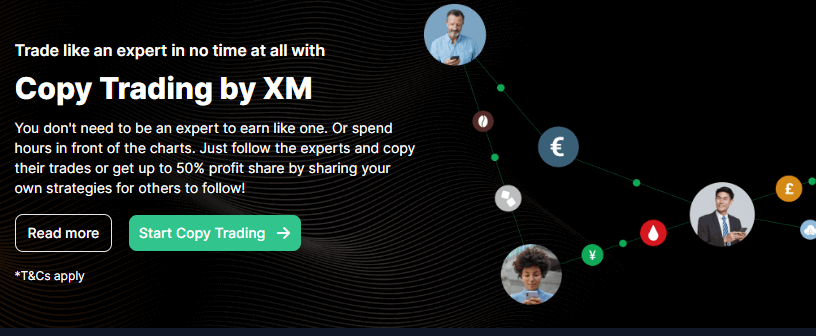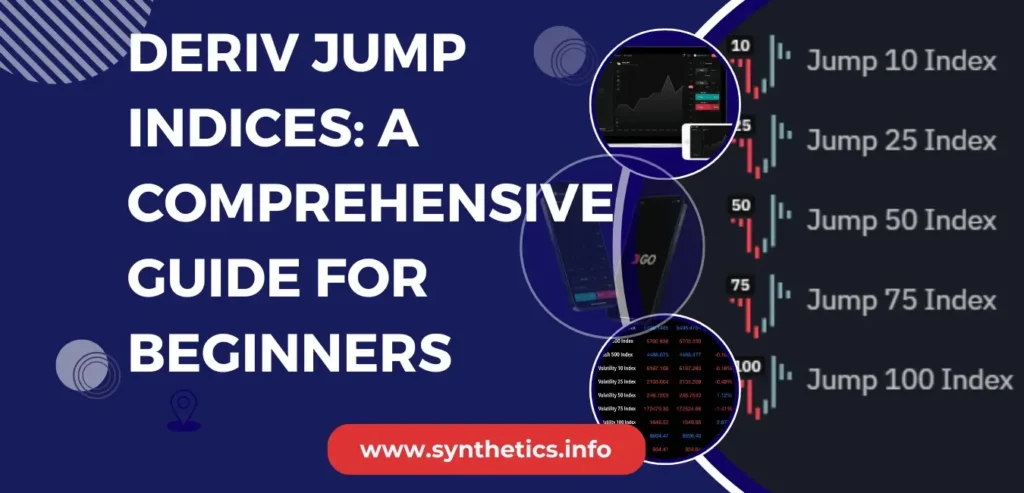Want to catch big price moves every 20 minutes? Welcome to Deriv Jump Indices.
Jump Indices are Deriv-exclusive synthetic instruments built for volatility. Each index has predictable spikes and controlled risk levels. In this guide, I’ll break down the differences between them, show you the lot sizes, and walk you through how to start trading them — even if you’re a complete beginner.
🔎 What Are Jump Indices From Deriv?
Jump Indices simulate markets that “jump” roughly every 20 minutes. These jumps are sharp, frequent, and algorithmically generated, meaning there are no news shocks or unexpected gaps. Here’s what makes them powerful:
- Fixed volatility (10% to 100%)
- Jumps average 30x the normal candle movement
- Equal probability of up or down price movement
- 24/7 availability — trade any day, any time
- No real-world news risk
 Read Review
OPEN AN ACCOUNT
Read Review
OPEN AN ACCOUNT
Min Deposit: USD 1
Total Pairs: 100+
Regulators: MFSA, LFSA, VFSC, BVIFSC
❓ How does the Jump Index work?
Jump Indices are synthetic markets created by Deriv, designed to simulate sudden, sharp price movements (“jumps”) at regular intervals. Each Jump Index is powered by a random number generator that’s coded to trigger a spike every 20 minutes on average — either up or down.
For example:
- Jump 10 Index has low volatility (10%) and moves gently
- Jump 100 Index has high volatility (100%) and makes huge spikes
The movement is fully algorithmic — there’s no news, no external influence, no fundamentals. Just clean, 24/7 price action.
That’s what makes them powerful for technical traders: you’re trading pure chart behavior in a market that never sleeps.
🔍 Types of Jump Indices (Explained)
Deriv offers five Jump Indices, each simulating a market with a fixed volatility level:
- Jump 10 – 10% volatility
- Jump 25 – 25% volatility
- Jump 50 – 50% volatility
- Jump 75 – 75% volatility
- Jump 100 – 100% volatility
All of them are designed to “jump” every ~20 minutes, with equal probability of moving up or down.
But here’s the thing — the volatility percentage alone doesn’t tell you which one to trade.
That’s why we ran a full 6-month candle analysis to break down the real movement, best times to trade, and strategy fit for each index. See the section below.

🏦 Which Broker Offers Jump Indices?
Only one — Deriv.
Deriv is the original creator of Jump Indices. They built the algorithm, they control the jump logic, and they’re the only broker licensed to offer them.
You won’t find Jump 10, 25, 50, 75, or 100 on Exness, IC Markets, or any MT4/MT5 broker outside the Deriv ecosystem.
If it’s not Deriv, it’s not a real Jump Index.
So if you’re searching for:
- “Jump 75 broker”
- “How to trade Jump 100 Index on TradingView”
- “Can I trade Jump Indices on MT4?”
The short answer is no. You’ll need a Deriv account, and specifically a Synthetic Indices account inside DMT5 (Deriv’s version of MetaTrader 5).
🔗 Here’s how to open a Deriv Synthetic account
⚖️ Minimum lot size for Jump Index
| Index | Min Lot Size |
| Jump 10 | 0.01 |
| Jump 25 | 0.01 |
| Jump 50 | 0.01 |
| Jump 75 | 0.01 |
| Jump 100 | 0.01 |
All Jump indices on Deriv have a minimum lot size of 0.01 on DMT5.
💰 How Much Is a “Point” Worth on Jump Indices?
Unlike forex, where we talk about pips, synthetic indices like Jump 10 or Jump 75 move in points — and each one has a fixed “point-to-dollar” value based on the instrument and your lot size.
To keep it simple:
📌 At 0.01 lot, most Jump Indices follow this rule:
→ 10,000 points = $1.00
→ So 1,000 points = $0.10
→ And 100 points = $0.01
That’s why even a small spike of 3,000–5,000 points can give you meaningful profit or hit your stop if you’re not careful.

📊 What’s the Typical 30-Minute Range of Jump Indices?
Based on 6 months of M30 candle data, here’s how each Jump Index performs during a normal 30-minute window — measured in median points and median dollar value (at 0.01 lot):
| Index | Median Range (pts) | Value @ 0.01 lot |
|---|---|---|
| Jump 10 | ~6,100 pts | ~$0.61 |
| Jump 25 | ~8,000 pts | ~$0.80 |
| Jump 50 | ~10,700 pts | ~$1.07 |
| Jump 75 | ~12,900 pts | ~$1.29 |
| Jump 100 | ~14,300 pts | ~$1.43 |
So if you enter on a breakout and it runs 8,000 points in your direction on Jump 25 — that’s around $0.80 profit (before spread) at 0.01 lot.
💸 Jump Indices: Minimum Deposit & Margin Requirements
Yes, you can deposit just $1 into your Deriv synthetic account — but don’t expect to trade Jump Indices with that. Been there, tried it — it doesn’t work.
These indices have strict margin requirements, and even the smallest lot sizes need more room than a $1 balance allows. You’ll keep getting “not enough money” errors when you try to place trades.
Here’s what I’ve found works in real trading conditions:
| Jump Index | Minimum Margin (0.01 lot) | Minimum Balance to Trade |
|---|---|---|
| Jump 10 Index | $0.39 | $5 |
| Jump 25 Index | $0.64 | $7 |
| Jump 50 Index | $0.62 | $7 |
| Jump 75 Index | $0.34 | $5 |
| Jump 100 Index | $0.06 | $5 |
👉 If you’re serious about trading Jump Indices, start with at least $5 to $10 depending on the index. This gives you enough margin to enter and survive small pullbacks — especially on volatile ones like Jump 50 or Jump 75.
📌 Pro tip: Always check your lot size and margin in the Deriv DMT5 platform before placing a trade. Even a $0.01 increase in margin can block your entry if you’re underfunded.
📝 How to Open an Account to Trade Jump Indices
You’ll need a Deriv Financial MT5 account to trade Jump Indices.
Here’s the quick setup:
- Create a Deriv Account – Go to Deriv signup page and register with your email.
- Add a Synthetic MT5 Account – From your dashboard, choose MT5 → Get Standard Account.
- Download MT5 – Install MetaTrader 5 on your phone or computer.
- Fund Your Wallet – Deposit via USD, crypto, or local payment agent.
- Start Trading – Log in to MT5 and search for “Jump Index” to begin.
👉 Need full instructions? Follow this step-by-step guide:
🔗 How to Open A Real Synthetic Indices Account

How to Trade Jump Indices (The Basics)
Jump Indices are a set of synthetic instruments on Deriv that “jump” every 20 minutes on average — simulating explosive market moves in a controlled, coded environment.
You can trade them 24/7, without worrying about news or gaps. And the higher the number (Jump 10 → Jump 100), the more volatile the index is.
Here’s how most traders approach them:
- Wait for a range or pause to form
- Use clean technical setups like breakouts or engulfing candles
- Time entries around the 20-min spike rhythm
- Start small — Jump 10 and Jump 25 are the most beginner-friendly
If you want full setups, chart logic, and my actual strategies for JD25, JD75, and JD100 — keep reading
📊 Which Jump Index Is the Most Volatile?
We analyzed over 6 months of 30-minute candle data across all 5 Jump Indices to answer a question many traders search for:
“Which Jump Index has the best movement?”
“When is the best time to trade Jump 75 or Jump 25?”
“Is Jump 100 still worth it in 2025?”
All dollar values below assume a trade size of 0.01 lot (standard for small accounts).
🔹 Jump 10 Index — Calm and Controlled
This is the most stable Jump Index, with a median 30-minute range of $1.20. It’s perfect for testing new setups or practicing tight SL placement.
The most active day is Saturday, where average 30-minute movement rises to $1.41, followed by Thursday ($1.27) and Monday ($1.25). The quietest days are Tuesday ($1.08) and Friday ($1.11).
For timing, 18:00 UTC is the most volatile session, peaking at $1.47 per candle. Other solid windows include 16:00 and 17:00 UTC, while the slowest hours are early morning — between 01:00 and 06:00 UTC, movement often falls below $1.00.
If you’re just starting out or scalping low risk, Jump 10 gives clean price action without brutal reversals.
🔹 Jump 25 Index — Big Bursts, Especially on Weekends
Jump 25 was the most volatile index overall, with a median M30 range of $4.25 and a top spike of $15.89 in a single 30-minute candle.
Its best day is Sunday, where median candles hit $4.66 — followed closely by Wednesday ($4.52) and Monday ($4.38). It cools off slightly on Saturday ($3.85) and Friday ($3.90).
The most active session is 17:00 UTC, where average candle size jumps to $4.83, with additional bursts around 14:00–20:00 UTC. Early morning hours like 03:00 or 06:00 UTC tend to be slower, closer to $3.70 per move.
If you’re using breakout strategies (Bollinger Bands, moving average crossovers), Jump 25 during weekends or late afternoon hours is where the gold is.
Overall, Jump 25 is ideal for breakout traders using Bollinger Bands, EMA crossovers, or spike-chasing bots. It’s especially rewarding if you lean into Sunday volatility, which many traders overlook.
🔹 Jump 50 Index — Momentum in the Middle
Jump 50 sits between power and control. This index strikes a balance between consistency and excitement.
The median range is $2.38, with regular candles stretching up to $8.83.
Saturday is the most active day at $2.62, followed by Wednesday ($2.49) and Sunday ($2.46). Slower sessions happen on Thursday ($2.27) and Friday ($2.23).
Peak movement comes at 12:00 UTC, where candles average $2.65. Other momentum windows include 15:00 ($2.59) and 18:00 ($2.57). If you’re trading overnight, expect a pullback in volatility — 02:00 to 04:00 UTC usually sees drops below $2.10.
Momentum traders using MACD, RSI, or order block breakouts can rely on Jump 50 for medium-risk setups.

🔹 Jump 75 Index — Consistent Action, Tight Windows
Jump 75 is a scalper’s sweet spot. It had a median range of $1.42, with candles occasionally stretching up to $5.61.
Thursday stands out as the most active trading day, where the average range hits $1.54, followed by Monday ($1.47) and Sunday ($1.45). If you’re looking to avoid low-movement periods, you’ll want to skip Tuesday ($1.34) and Friday ($1.33) — the two slowest days based on 30-minute median movement.
Volatility hits its peak at 18:00 UTC, with candles pushing up to $1.59 on average. Sessions around 14:00 and 20:00 UTC also stay above $1.50. The quietest periods are 01:00 to 05:00 UTC, where ranges often slip under $1.30.
Jump 75 rewards tight SLs, sniper entries, and aggressive profit booking. It’s a favorite for bots that use engulfing patterns or M1 scalping setups.
🧠 How Do I Trade the Jump 75 Index?
The Jump 75 Index is a sweet spot — volatile enough to deliver solid moves, but not as chaotic as Jump 100. It’s ideal for price action scalping and structured entries.
One strategy that works well on Jump 75 is the engulfing candle + trend logic:
- Wait for a small pullback during a trend
- Enter on a strong engulfing candle (preferably near a key level)
- Use a 1:2 risk-reward ratio or trail your stop behind structure
- Best trading times: 16:00 to 21:00 UTC, especially on Mondays and Thursdays

🔹 What is the Jump 100 Index?
The Jump 100 Index is tcoded to simulate 100% volatility with sharp moves every 20 minutes on average.
Surprisingly, Jump 100 turned out to be the least volatile of the group — at least on the M30 chart. It recorded a median 30-minute range of just $0.33, with highs rarely breaking past $1.61. Thursday again came out on top with average ranges around $0.37, followed by Wednesday ($0.36) and Sunday ($0.35). The calmest days were Tuesday ($0.30) and Friday ($0.31).
In terms of timing, the strongest bursts happen at 07:00 UTC, where ranges hit $0.38. Other active hours include 11:00 ($0.36) and 14:00 ($0.35). By contrast, the deadest hours are from 00:00 to 03:00 UTC, with candle sizes dropping to $0.28–$0.29 on average.
Despite the name, Jump 100 isn’t the most explosive index. It’s better suited for tick-chart trading or bots that take dozens of tiny profits — not swing setups or wide-stop strategies.
🟢 Best Jump Index for Beginners (Start Here)
If you’re starting out, don’t touch Jump 100.
The best place to begin is Jump 10 Index — and here’s why:
- It’s the least volatile Jump pair
- It gives you more time to read candles and react
- The spikes still happen, but they’re measured — not instant account-killers
From our 6-month data analysis, here’s how Jump 10 performs:
- 🟩 Median 30-minute range: ~$1.20
- 🟩 Most active day: Saturday (average $1.41 range)
- 🟩 Best hours: 16:00–18:00 UTC
Jump 25 is a good next step once you’ve got a few clean setups working.
💡 Tip: Use demo mode with 0.01 lots until you can hit at least 60% win rate over 30–50 trades. That tells you you’ve got something worth risking real funds on.

🚀 How to Trade Jump Indices (Step-by-Step for Real Traders)
Jump Indices don’t move like forex. They’re coded to “jump” every 20 minutes on average — and once you get used to that rhythm, you can build solid setups around it.
Here’s a no-fluff approach that’s worked for me:
1. Choose your index based on speed.
- Jump 10 or 25 for slow, controlled price action
- Jump 75 or 100 if you want faster, more aggressive moves
- Jump 50 is middle-of-the-road and behaves well with trend-following setups
2. Look for build-up before the spike.
The spikes don’t come from nowhere. Watch for price stalling or consolidating just before a candle close — that’s often your cue something’s brewing.
3. Use clean chart setups.
What’s worked for me:
- Engulfing candles + trend alignment
- Breakouts after 3+ tight candles
- Fakeout-wick rejections near structure
4. Manage your stop loss in points.
You’re trading synthetic instruments, not currency pairs — so everything is point-based. A 5,000-point SL on Jump 25 is completely different from the same value on Jump 100. Know your decimals.
5. Respect the rhythm.
These indices are coded to move around every 20 minutes — not every candle will jump, but many do. You can test this on demo and see the rhythm for yourself.
🔗 See below for strategy examples, TP/SL breakdowns, and volatility stats.

🔬 Jump Index Strategies (That Actually Work)
1. Time-Based Jump Sniping (All Indices)
Jump Indices are designed to “jump” roughly every 20 minutes. You can build setups around this rhythm. Monitor when price consolidates and prepare to strike just before the next scheduled movement.
2. Structured Breakouts (Best: Jump 25 & Jump 50)
Both Jump 25 and Jump 50 showed explosive bursts — ideal for breakout traders. Use Bollinger Bands or price channel breakouts around 14:00–20:00 UTC. Target clean structure zones and trail your SL once you’re in profit.
3. Momentum Scalping (Best: Jump 75)
Jump 75 moves fast, especially between 14:00–20:00 UTC. Use momentum tools like RSI or MAs to catch intra-candle bursts. Entry precision matters — tight stops, short holds.
4. Steady Trend Testing (Best: Jump 10)
Jump 10 offers smaller, more consistent moves. Perfect for testing new strategies or swing setups without high risk. Trade between 16:00–18:00 UTC when activity increases.
5. High-Frequency Ticks Only (Jump 100)
Jump 100 moves fast, but not far — it’s not suitable for swing trading. Focus on tick chart scalping or 1-minute expiry bots. Aim for frequent micro gains, not wide targets.

📥 Download: Jump Index Strategy PDF (2025 Edition)
Want proven setups for Jump 10, 25, 75, and 100?
I’ve put together a free strategy pack you can download — includes real examples, entry rules, SL/TP logic, and timing insights based on data from the past 6 months.
Perfect if you’re searching for:
“jump index strategy PDF”, “jump 75 index strategy”, or “how to trade jump indices”
👉 Click here to download the full Jump Index Strategy Pack (PDF)
No signup required. Just open, read, and test on demo.
✅ Advantages Of Trading Jump Indices (Real Talk)
1. They’re Open 24/7 — No Waiting Around
One of the best things about Jump Indices? You can trade them anytime. No market hours, no weekend shutdowns. If you feel like trading at 2AM or during a public holiday, it’s live.
For those of us juggling other hustles or who trade at odd hours — this is a massive advantage.
2. The Moves Are Timed, Not Random
Every Jump Index has fixed volatility (Jump 10 = 10%, Jump 100 = 100%), and they’re coded to spike roughly every 20 minutes.
Once you understand that rhythm, you can literally build your trading routine around it. It’s not perfect, but it’s consistent — and that’s what matters.
3. No News. No Surprises. Just Charts.
These are synthetic markets. No central bank speeches, no surprise tweets, no CPI reports wrecking your setup.
If you’ve ever been stopped out by a news spike in forex, you’ll love how “quiet” Jump Indices are. It’s just you and the chart.
4. You Don’t Need $100 to Get Started
Jump Indices let you trade with as little as $5 to $10, depending on the pair. The margin requirements are low — I’ve placed trades with less than $1 before.
If you’re trading small or trying to grow a tiny account, this is where you start. Just don’t over-leverage.
5. What You Click Is What You Get
Execution is clean. No random slippage. Forget wild spreads. No “delayed fill” nonsense you sometimes get with other brokers.
For price action traders and scalpers, this reliability matters. You see the setup, you enter, and the trade executes as expected. Simple.

⚠️ Cons of Trading Jump Indices (What No One Tells You)
1. That Same Volatility Can Wipe You Out
Yes, the jumps can pay — but they can also punish.
If your entry isn’t sharp or you’re trading based on emotion, one candle is enough to take you out. Especially on Jump 75 and Jump 100 — those two can flip direction in seconds and don’t wait for your analysis to catch up.
2. You’re Stuck With Deriv
Love it or hate it, Jump Indices are exclusive to Deriv.
That means you can’t trade them on TradingView or cTrader, and you won’t find them on other brokers. If you’re not a fan of Deriv’s platform or support, there’s no alternative. It’s a closed system — take it or leave it.
3. You’ll Be Tempted to Overtrade
Markets open 24/7 sound like a dream until you find yourself overtrading.
Because Jump Indices are always moving, it’s easy to think “just one more trade” — and next thing you know, you’re 20 trades deep chasing after setups that weren’t even clean.
I’ve done it. Most traders have. Don’t make this a habit.
4. No Fundamentals to Guide You
There’s no news calendar, no economic reports, nothing to give you directional bias outside of the chart.
If you’re used to trading based on fundamentals, this can feel like flying blind. It’s all price action and technicals here — you either adapt or sit out.
5. They Look Beginner-Friendly — But They’re Not
Low margin requirements and 24/7 access make Jump Indices look perfect for new traders. But the truth is, most beginners blow their first small account here.
Jump 100 especially gives off “easy money” vibes — until it slaps you. If you’re just starting out, use demo first, get a feel for the rhythm, then go live with tight risk control.
🔗 Related Guides You’ll Find Useful

🧠 Final Thoughts On Deriv Jump Indices
Jump Indices can be incredibly rewarding — but they’re not plug-and-play. You need timing, a solid risk plan, and a strategy that fits the behavior of the index you’re trading.
We’ve shared real data, tips, and setups that work. Now it’s your turn.
What’s been your experience with Jump Indices?
Which one is your favorite to trade — and why?
Have you found any time blocks or price patterns that give you an edge?
👇 Drop your insights, strategies, or hard lessons in the comments. Someone out there is where you were last year — your tip might be what helps them turn the corner.
Let’s grow the community, sharpen our skills, and build smarter traders together.
If this guide helped you, share it with your team or group chat — let’s keep the knowledge moving.
FAQs On Deriv Jump Indices
Jump 10 Index. It’s slow and steady with low risk.
Jump 10 Index is the best option for new traders. It has the lowest volatility, more predictable candles, and smaller 30-minute ranges, making it easier to manage trades with a small account.
ou can trade most Jump Indices with just 0.01 lots. That means even a $5–$10 account is enough to start — especially on slower pairs like Jump 10 and 25.
Jump Indices are programmed to spike roughly every 20 minutes. The most active periods are between 14:00 and 21:00 UTC based on our volatility analysis.
You can view live Jump Index charts on the Deriv web terminal or MT5 app. Each index has tick, minute, and hourly charts available 24/7.
Only Deriv offers Jump Indices. They created and maintain the algorithm, and no other broker has access to it.
Not directly. You can view charts using TradingView tools inside Deriv’s platform, but Jump Indices are exclusive to Deriv. You can’t trade them through TradingView’s own brokerage or broker plugins.






💼 Recommended Brokers to Explore
Other Posts You May Be Interested In
V75 Index Scalping Strategy: A Complete Guide for Quick Profits (2025) 💰
📅 Last updated: March 10, 2025 ✍️ Written by: Jafar Omar ✅ Fact-checked by: Taylor [...]
🤖 Deriv Even Digit Bot – Oryx Strategy Explained
📅 Last updated: June 22, 2025 ✍️ Written by: Jafar Omar ✅ Fact-checked by: Taylor [...]
Deriv Wallet: How It Works, P2P Rules & Transfer Limits (2025)
📅 Last updated: July 15, 2025 ✍️ Written by: Jafar Omar ✅ Fact-checked by: Taylor [...]
Varus – Deriv Under 5 Bot with Safe PLS Recovery Strategy (2025)🤖
📅 Last updated: June 23, 2025 ✍️ Written by: Jafar Omar ✅ Fact-checked by: Taylor [...]
⚡Top 5 Most Volatile Synthetic Indices on Deriv & How To Trade Them In 2025
📅 Last updated: May 25, 2025 ✍️ Written by: Jafar Omar ✅ Fact-checked by: Taylor [...]
FBS Review 2024 🔍 Is It A Good Broker?
📅 Last updated: December 11, 2023 ✍️ Written by: Jafar Omar ✅ Fact-checked by: Taylor [...]